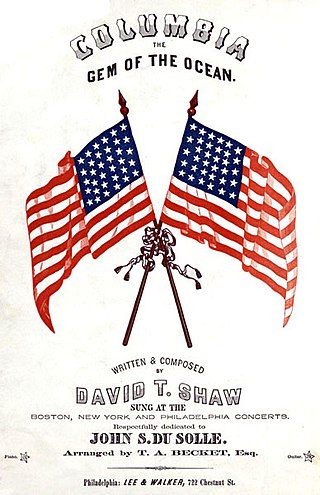"How High the Moon" is a jazz standard with lyrics by Nancy Hamilton and music by Morgan Lewis. It was first featured in the 1940 Broadway revue Two for the Show, where it was sung by Alfred Drake and Frances Comstock. In Two for the Show, this was a rare serious moment in an otherwise humorous revue.
"On, Wisconsin!" is the fight song of the Wisconsin Badgers at the University of Wisconsin–Madison. A version with modified lyrics is the official state song of Wisconsin.

"Hail, Columbia" is an American patriotic song and ceremonial entrance march of the vice president of the United States. It was originally considered to be one of the unofficial national anthems of the United States until 1931, when "The Star-Spangled Banner" was named as the official national anthem. Columbia is the name for the national personification of the United States which originated during the 18th century.

The "Battle Cry of Freedom", also known as "Rally 'Round the Flag", is a song written in 1862 by American composer George Frederick Root (1820–1895) during the American Civil War. A patriotic song advocating the causes of Unionism and abolitionism, it became so popular that composer H. L. Schreiner and lyricist W. H. Barnes adapted it for the Confederacy.
The Aggie War Hymn is the war hymn of Texas A&M University; officially, the school does not have a fight song.

"Columbia, the Gem of the Ocean" is an American patriotic song which was popular in the United States during the 19th and early 20th centuries. Composed c. 1843, it was long used as an unofficial national anthem of the United States, in competition with other songs. Under the title "Three Cheers for the Red, White, and Blue," the song is mentioned in Chapter IX of MacKinlay Kantor's Pulitzer Prize-winning novel Andersonville (1955). It was also featured in the 1957 musical The Music Man. In 1969, "Columbia, the Gem of the Ocean" was the music performed by a U.S. Navy Band embarked aboard USS Hornet as one of the ship's helicopters recovered the Apollo 11 astronauts from their capsule named Columbia after a splashdown in the Pacific Ocean.
"Blues in the Night" is a popular blues song which has become a pop standard and is generally considered to be part of the Great American Songbook. The music was written by Harold Arlen, the lyrics by Johnny Mercer, for a 1941 film begun with the working title Hot Nocturne, but finally released as Blues in the Night. The song is sung in the film by William Gillespie.

The Varsity Show is one of the oldest traditions at Columbia University and its oldest performing arts presentation. Founded in 1894 as a fundraiser for the university's fledgling athletic teams, the Varsity Show now draws together the entire Columbia undergraduate community for a series of sold-out performances every April. Dedicated to producing a unique full-length spectacle that skewers and satirizes many dubious aspects of life at Columbia, the Varsity Show is written and inspired by an extensive team of cast, producers and production personnel.
"Ten Thousand Men of Harvard" is the most frequently performed of Harvard University's fight songs. Composed by A. Putnam of Harvard College's class of 1918, it is among the fight songs performed by the Harvard Glee Club at its annual joint concert with the Yale Glee Club the night before the annual Harvard-Yale football game, as well as at the game itself. It is also played or sung at other athletic meets or other intercollegiate contests, usually by the Harvard University Band.

The "UNH Alma Mater" is the official alma mater of the University of New Hampshire in Durham, New Hampshire. The lyrics to the song were written by Herbert Fisher Moore, an 1898 graduate of the school, and are sung to the tune "Lancashire" by Henry Smart.
Oskee Wow-Wow is the official fight song of the University of Illinois at Urbana-Champaign. The song was written in 1910 by two students: Harold Vater Hill '11 (1889–1917), credited with the music, and Howard Ruggles Green '12 (1890–1969), credited with the lyrics.

"Spanish Ladies" is a traditional British naval song, describing a voyage from Spain to the Downs from the viewpoint of ratings of the Royal Navy.

Columbia University has developed many traditions over its 269-year-long existence, most of them associated with its oldest undergraduate division, Columbia College.
"Waves of the Danube" is a waltz composed by Iosif Ivanovici in 1880, and is one of the most famous Romanian tunes in the world. The song has many variations throughout the piece, reminiscent of the music of Johann Strauss. Through the Viennese style variations, there is still a distinct Slavic style. In the United States, it is frequently referred to as "The Anniversary Song", a title given by Al Jolson when he and Saul Chaplin released an adaptation of the song in 1946.

"Hail to Pitt" is the most traditional fight song of the University of Pittsburgh, which is commonly referred to as Pitt. The saying "Hail to Pitt!" is also the most traditional and commonly used slogan of the University of Pittsburgh and its athletics teams. The slogan is frequently used in promotional material, printed on merchandise and souvenirs. It was also the title of a 1982 history of Pitt athletics by author Jim O'Brien. The slogan is often used among alumni as a statement of affiliation, including as a closing signature in conversation or correspondence between alumni, and is sometime abbreviated as "HTP" or "H2P", the latter of which is a registered trademark of the university and is frequently used on official university signage and merchandise.

The alma mater of the University of Pittsburgh was adopted soon after the University changed its name in 1908 from the Western University of Pennsylvania to its current moniker. Lyrics were written by George M. P. Baird, class of 1909 and were set to the tune of what was then the Austrian National Anthem. A new tune for the "Alma Mater" hymn was composed by Charles W. Scovel, class of 1883, but it was not widely adopted and was either lost or became obscure.
"March On! " is the official school fight song of Indiana State University. The song and lyrics were written by ISU professor of music Joseph A. Gremelspacher as a pep song.
The Minnesota State Rouser, also known as The Maverick Rouser is the fight song of the Minnesota State University, Mankato. It is played at all Minnesota State Mavericks athletics games, rallies and at many alumni events. The Maverick Machine, the Minnesota State University Marching Band, plays the rouser along with other popular songs and the song of the university, the Minnesota State University Hymn.
"Varsity" is a fight song of the University of Michigan.
"Stand, Columbia" is the official alma mater of Columbia University in New York City, New York. It was written in Gilbert Oakley Ward for the university's 1902 Class Day ceremonies, and is sung to the tune of Joseph Haydn's "Gott erhalte Franz den Kaiser", which served as the melody for the Austrian national anthem until 1938, and was adopted as the German national anthem in 1922. The hymn is traditionally played at the university's baccalaureate services and commencements.












